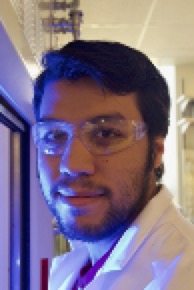Org. Synth. 2020, 97, 355-367
DOI: 10.15227/orgsyn.097.0355
Nickel-Catalyzed Arylboration of Cyclopentene
Submitted by Stephen R. Sardini and M. Kevin Brown*
Checked by Raymond Turro and Sarah Reisman
1. Procedure (Note 1)
A.
cis-2-(2-(4-Chlorophenyl)cyclopentyl)-4,4,5,5-tetramethyl-1,3,2-dioxa-borolane (2). A 500-mL, three-necked, round-bottom flask (24/40 ground glass joint, Flask A) is equipped with a 4.5 x 1.75-cm magnetic stir bar (Teflon-coated, egg-shaped), a rubber septum, a glass stopper, and a vacuum adapter with a stopcock (in the open position; connected to a dual manifold with bubbler). Flask A is evacuated (0.3 mmHg), flame-dried, and allowed to cool to room temperature under vacuum (Figure 1). The flask is then backfilled with a nitrogen atmosphere.
Figure 1. Assembled reaction apparatus (flask A)
(photo provided by submitter)
Flask A is then charged with
bis(pinacolato)diboron (12.7 g, 50.0 mmol, 2.00 equiv) (
Note 2),
1-bromo-4-chlorobenzene (7.18 g, 37.5 mmol, 1.50 equiv) (
Note 3), and
sodium tert-butoxide (3.60 g, 37.5 mmol, 1.50 equiv) (
Note 4). The flask is then purged with a nitrogen atmosphere by three evacuation-backfill cycles (
Note 5). Anhydrous
THF (225 mL) (Notes
6 and
7) is then added via syringe and the suspension stirred in a 30 °C water bath for 30 min. A 50-mL Schlenk flask (14/20 joint, Flask B) is equipped with a rubber septum, evacuated (0.3 mmHg), and flame-dried. Flask B is allowed to cool under vacuum and backfilled with a nitrogen atmosphere before being charged with
nickel dichloride (dimethoxyethane adduct) (286 mg, 1.30 mmol) (
Note 8). Flask B is then purged with a nitrogen atmosphere by three evacuation-backfill cycles (
Note 9).
N,N-Dimethylacetamide (26 mL) (
Note 10) is then added via syringe to flask B, and flask B is swirled to completely dissolve the
nickel dichloride (dimethoxyethane adduct) (Figure 2).
Figure 2. Flask B containing catalyst solution
(photo provided by submitter)
Figure 3. Flask A after the addition of catalyst solution from flask B
(photo provided by submitter)
Cyclopentene (2.2 ml, 25 mmol, 1 equiv) (
Note 11), followed by the catalyst solution from flask B (25 mL, 1.25 mmol, 5 mol% catalyst loading), are added to flask A sequentially via syringe. The stopcock on the vacuum adapter is then closed and a nitrogen inlet (connected to a Schlenk line and bubbler) is inserted into the rubber septum. The now purple suspension is allowed to stir at 30 ºC for 24 h (
Note 12) (Figure 3), during which the suspension took on a light pink color (Figure 4).
Figure 4. Flask A containing the reaction mixture after 24 h
(photo provided by submitter)
The reaction mixture is then transferred to a 1000-mL separatory funnel containing 1 M
hydrochloric acid (200 mL) (
Note 13).
Diethyl ether (50 mL) (
Note 14) is used to rinse the round-bottomed flask and the ether is added to the separatory funnel. The separatory funnel is sealed with a glass stopper and shaken. The aqueous layer is separated from the organic layer and the organic layer placed in a 1000-mL Erlenmeyer flask. The aqueous layer is then extracted with
diethyl ether (2 x 150 mL). The organic extracts are combined in the 1000-mL Erlenmeyer flask, and the aqueous layer is discarded. The contents of the 1000-mL Erlenmeyer flask are transferred back into the 1000‑mL separatory funnel and washed with 1 M
potassium hydroxide (3 x 200 mL) (
Note 15). The organic layer is transferred to the 1000-mL Erlenmeyer flask, the aqueous layer is discarded, and
diethyl ether (50 mL) is used to rinse the separatory funnel and added to the Erlenmeyer flask. The organic layer is dried over
magnesium sulfate (15 g) (
Note 16), and gravity filtered through filter paper into a 1000-mL round-bottomed flask. The 1000‑mL Erlenmeyer flask is rinsed with
diethyl ether (50 mL), which is filtered through the filter paper, and the filter paper is rinsed with additional
diethyl ether (50 mL). The solvent then is removed under reduced pressure via rotary evaporation (ca. 10 mmHg, water bath temperature 30 ºC), and further dried at 0.3 mmHg for 1 h to provide the crude mixture as a yellow oil. The crude mixture is purified via silica gel flash column chromatography with
hexanes and
diethyl ether as the eluent (Notes
17,
18, and
19). The product-containing fractions are transferred to a 1-L round-bottomed flask and concentrated via rotary evaporation (ca. 10 mmHg, water bath temperature 30 ºC). The resulting oil is transferred to a pre-weighed 20-mL scintillation vial. The flask is rinsed with
diethyl ether (3 x 3 mL) to ensure quantitative transfer. The contents of the scintillation vial are concentrated via rotary evaporation (ca. 10 mmHg, water bath temperature 30 ºC), and dried at 0.3 mmHg for 4 h to yield
2 (6.67 g, 87%) as an air and moisture stable white solid (Notes
20 and
21) (Figure 5).
Figure 5. Pure product after chromatography
(photo provided by submitter)
2. Notes
1. Prior to performing each reaction, a thorough hazard analysis and risk assessment should be carried out with regard to each chemical substance and experimental operation on the scale planned and in the context of the laboratory where the procedures will be carried out. Guidelines for carrying out risk assessments and for analyzing the hazards associated with chemicals can be found in references such as Chapter 4 of "Prudent Practices in the Laboratory" (The National Academies Press, Washington, D.C., 2011; the full text can be accessed free of charge at
https://www.nap.edu/catalog/12654/prudent-practices-in-the-laboratory-handling-and-management-of-chemical. See also "Identifying and Evaluating Hazards in Research Laboratories" (American Chemical Society, 2015) which is available via the associated website "Hazard Assessment in Research Laboratories" at
https://www.acs.org/content/acs/en/about/governance/committees/chemicalsafety/hazard-assessment.html. In the case of this procedure, the risk assessment should include (but not necessarily be limited to) an evaluation of the potential hazards associated with
Bis(pinacolato)diboron,
1-bromo-4-chlorobenzene,
sodium tert-butoxide,
tetrahydrofuran,
nickel dichloride (dimethoxyethane adduct),
N,N-dimethylacetamide,
cyclopentene,
hydrochloric acid,
diethyl ether,
potassium hydroxide,
magnesium sulfate,
hexanes, and silica gel.
2.
Bis(pinacolato)diboron (99%) was purchased from Oakwood and recrystallized via the following procedure: A 2-L Erlenmeyer flask equipped with a magnetic stir bar (teflon coated, 4.5x1.75) was charged with
bis(pinacolato)diboron (100 g), and pentane (700 mL). The flask was stirred in a 50 ºC water bath to bring the solvent to a boil. Additional pentane was added until all the solids were dissolved (final volume of the solution is usually 900 mL). The solution was allowed to cool to room temperature, at which point crystallization is observed. The flask was then sealed with parafilm and placed in a -20 ºC freezer for 2 h. The crystals were collected via vacuum filtration on a fritted Büchner funnel. The crystals were transferred to a 1-L round-bottomed flask and dried at 0.3 mmHg for 3 h. A slight excess of
bis(pinacolato)diboron is used in the arylboration reaction due to the concomitant formation of arylboronic ester which arises from borylation of the arylbromide.
3.
1-Bromo-4-chlorobenzene (99%) was purchased from Sigma-Aldrich and used as received. A slight excess of arylbromide is used in the arylboration reaction due to the concomitant formation of arylboronic ester, which arises from borylation of the arylbromide.
4.
Sodium tert-butoxide (>98%) was purchased from Strem and used as received. A slight excess of base is used in the arylboration reaction due to the concomitant formation of arylboronic ester, which arises from borylation of the arylbromide.
5. The flask was evacuated, and held under vacuum (0.3 mmHg) for 2 min before backfilling with nitrogen. This process was repeated for a total of three times.
6.
Tetrahydrofuran (Anhydrous, ≥99.9%, inhibitor free) was purchased from Sigma-Aldrich was collected in an oven-dried (140 ºC for 24 h) 250 mL Schlenk flask, which had been purged with an argon atmosphere by three evacuation-backfill cycles from a dry solvent system (Innovative Technology).
7. Addition of
THF was conducted while the solids were being stirred to minimize the amount of insoluble material that sticks to the walls of the flask, as the addition of
THF yields a suspension.
8.
Nickel dichloride (dimethoxyethane adduct) (>97%) was purchased from Strem and used as received.
9. The flask was evacuated and held under vacuum (0.3 mmHg) for 2 min before backfilling with nitrogen. This process was repeated for a total of three times.
10.
N,N-Dimethylacetamide (Anhydrous, 99.8%) was purchased from Sigma-Aldrich in Sure-Seal™ bottles and used as received.
11.
Cyclopentene (97%) was purchased from Beantown Chemical and used as received.
12. It is generally observed that at the beginning of the reaction there are some solids on the walls of the flask. This is not detrimental, and the solids become fully suspended in the reaction mixture throughout the course of the reaction (see Figure 2).
13. Concentrated
hydrochloric acid was purchased from Macron and used as received.
14.
Diethyl ether (>99%) was purchased from Fisher Chemical and used as received.
15.
Potassium hydroxide (≥85%) was purchased from Macron and used as received. Washing with aqueous
KOH removes the arylboronic ester side product as well as excess
bis(pinacolato)diboron.
16.
Magnesium sulfate (≥98.0%) was purchased from Merck and used as received.
17. Thin layer chromatograph was performed on silica gel 60 F254 TLC plate (Merck TLC Silica Gel 60 Glass Plates) with 20:1
hexanes:
diethyl ether as eluent. The product (R
f 0.29) was visualized under 254 nm UV light and
KMnO4 stain. The TLC plate is shown in Figure 6 (Lane A: Crude reaction mixture; Lane B: product after silica gel column chromatography). Any remaining arylbromide will not stain with
KMnO4, thus visualization with 254 nm UV light is necessary.
Figure 6. TLC analysis of crude mixture (A) and product after chromatography (B) (left: under 254 UV light; right: KMnO4 stain)
(photo provided by submitter)
18. Silica gel (pore size 60 Å, 230-400 mesh, 40-63 µm particle size) was purchased from Sigma-Aldrich and used as received.
19. The crude product was loaded onto a column packed with silica gel slurried in
hexanes.
Hexanes (5 mL) was used to rinse the flask that contained the crude mixture and loaded on the column. The column is 9 cm in diameter, with 300 g of silica added as a slurry in
hexanes. The column was eluted with 200 mL of
hexanes followed by 200 mL of a 20:1
hexanes:
diethyl ether mixture. At this point 25 mL fractions were collected while continuing to elute with a 20:1
hexanes:
diethyl ether solvent mixture. Product was contained in fractions 31-62.
20. The product was isolated as an air/moisture stable clear colorless oil which solidified to a low-melting white solid upon storage at -20 ºC, and the compound had the following characteristics: mp = 26-27 ºC;
1H NMR
pdf (400 MHz, CDCl
3) δ: 0.94 (s, 6H), 0.98 (s, 6H), 1.58 - 1.71 (m, 1H), 1.79 (dddd, J = 15.8, 12.1, 7.9, 1.7 Hz, 3H), 1.85 - 1.97 (m, 2H), 2.00 - 2.14 (m, 1H), 3.33 (dt, J = 8.7, 7.5 Hz, 1H), 7.13 - 7.23 (m, 4H);
13C NMR
pdf (101 MHz, CDCl
3) δ: 24.7, 24.8, 26.6, 28.2, 34.0, 46.8, 82.91, 128.0, 129.6, 131.3, 145.2 (the carbon directly attached to boron is not detected due to quadrupolar relaxation);
11B NMR
pdf (128 MHz, CDCl
3) δ: 33.36; IR (film or solvent): 2976, 2871, 2360, 1491, 1320, 1265, 1215, 1143, 1091, 1014, 974, 828 cm
-1; HRMS (CI+)
m/z calcd for C
17H
25BO
2Cl [M+H]
+: 307.1636. Found: 307.1636.
21. The purity was determined to be 97 wt. % via quantitative
1H NMR
pdf (600 MHz, CDCl
3) using
1,3,5-trimethoxybenzene as the internal standard.
1,3,5-trimethoxybenzene (99%) was purchased from Sigma-Aldrich and used as received.
22. A second reaction performed on identical scale provided 6.51 g (85%) of the identical product.
Working with Hazardous Chemicals
The procedures in
Organic Syntheses are intended for use only by persons with proper training in experimental organic chemistry. All hazardous materials should be handled using the standard procedures for work with chemicals described in references such as "Prudent Practices in the Laboratory" (The National Academies Press, Washington, D.C., 2011; the full text can be accessed free of charge at
http://www.nap.edu/catalog.php?record_id=12654). All chemical waste should be disposed of in accordance with local regulations. For general guidelines for the management of chemical waste, see Chapter 8 of Prudent Practices.
In some articles in Organic Syntheses, chemical-specific hazards are highlighted in red "Caution Notes" within a procedure. It is important to recognize that the absence of a caution note does not imply that no significant hazards are associated with the chemicals involved in that procedure. Prior to performing a reaction, a thorough risk assessment should be carried out that includes a review of the potential hazards associated with each chemical and experimental operation on the scale that is planned for the procedure. Guidelines for carrying out a risk assessment and for analyzing the hazards associated with chemicals can be found in Chapter 4 of Prudent Practices.
The procedures described in Organic Syntheses are provided as published and are conducted at one's own risk. Organic Syntheses, Inc., its Editors, and its Board of Directors do not warrant or guarantee the safety of individuals using these procedures and hereby disclaim any liability for any injuries or damages claimed to have resulted from or related in any way to the procedures herein.
3. Discussion
Alkene arylboration reactions are useful transformations to rapidly build up chemical complexity from ubiquitous, easily synthesized alkenes. These processes allow for the installation of a new C-C bond and a new C-B bond, the latter of which is a useful functional group.
2 Our lab has recently disclosed a series of Ni-catalyzed arylboration reactions.
3 These reactions allow for the 1,2-arylboration of unactivated alkenes, a previously unmet challenge. This method is shown in the above procedure, and proceeds smoothly for a variety of alkenes and arylbromides (Table 1
3-
9).
Table 1. Representative Scope of Ni-catalyzed Arylboration
These reactions are highly stereoselective, such that the syn-arylboration product is always observed; moreover, the reaction is stereospecific (compare products 5 and 6). Use of 1,1-disubstituted and trisubstituted alkenes allows for the formation of quaternary centers with high levels of regioselectivity in all cases (products 5-9). This is significant as the synthesis of fully substituted carbons is a contemporary challenge in organic synthesis.
The synthetic utility of the C-B bond is demonstrated by various stereospecific functionalizations. Oxidation to the alcohol or amine proceeds smoothly to achieve net hydroxylarylation and aminoarylation of
cyclopentene (products
11 and
12, respectively).
4 Additionally, a new C-C bond can be installed via a Zwiefel olefination (product
10).
5
Scheme 1. Further functionalization of boronic ester 2
Appendix
Chemical Abstracts Nomenclature (Registry Number)
Bis(pinacolato)diboron: 2,2'-Bi-1,3,2-dioxaborolane, 4,4,4',4',5,5,5',5'-octamethyl-; (73183-34-3)
1-Bromo-4-chlorobenzene: Benzene, 1-bromo-4-chloro-; (106-39-8)
Sodium tert-butoxide: 2-Propanol, 2-methyl-, sodium salt; (865-48-5)
THF: Furan, tetrahydro-; (109-99-9)
Nickel dichloride (dimethoxyethane adduct): Nickel, dichloro[1,2-di(methoxy-κO)ethane]-; (29046-78-4)
N,N-Dimethylacetamide: Acetamide, N,N-dimethyl-; (127-19-5)
Cyclopentene: Cyclopentene; (1) (142-29-0)
Hydrochloric acid: Hydrochloric acid; (7647-01-0)
Diethyl ether: Ethane, 1,1'-oxybis-; (60-29-7)
Potassium hydroxide: Potassium hydroxide, (K(OH)); (1310-58-3)
Magnesium sulfate: Sulfuric acid magnesium salt (1:1); (7487-88-9)
1,3,5-Trimethoxybenzene: Benzene, 1,3,5-trimethoxy-; (621-23-8)

|
Stephen R. Sardini was born in Fairfax, Virginia and grew up in Newark, Ohio. He obtained his B.S. in chemistry at The Ohio State University and began his graduate work under the direction of Prof. M. Kevin Brown at Indiana University in 2014. Stephen's Ph.D. thesis focused on the development of metal catalyzed arylboration reactions. In 2020, Stephen graduated with his Ph.D. and began an NIH funded postdoctoral fellowship in Prof. Brian Stoltz's lab at CalTech. |

|
M. Kevin Brown grew up in the suburbs of Chicago. Kevin received his B.A. degree from Hamilton College in 2002 and then moved to Boston College to pursue graduate studies under the mentorship of Professor Amir Hoveyda. Upon completion of his graduate studies, he began a postdoctoral fellowship in the laboratories of E.J. Corey at Harvard University. In 2011 he began his independent career at Indiana University as an assistant professor and was promoted to associate professor in 2016. |

|
Ray Turro was born and raised in Ridgewood, NJ. He received his B.S. in chemistry from Juniata College working for Dr. John Unger on asymmetric copper-hydride reductions to prepare chiral aziridines. He also spent time in the lab of Dr. Uttam Tambar at UT Southwestern working on method development and medicinal chemistry projects. He joined the Reisman Lab in 2018 to develop asymmetric nickel-catalyzed cross-coupling reactions and study their mechanism. |
Copyright © 1921-, Organic Syntheses, Inc. All Rights Reserved